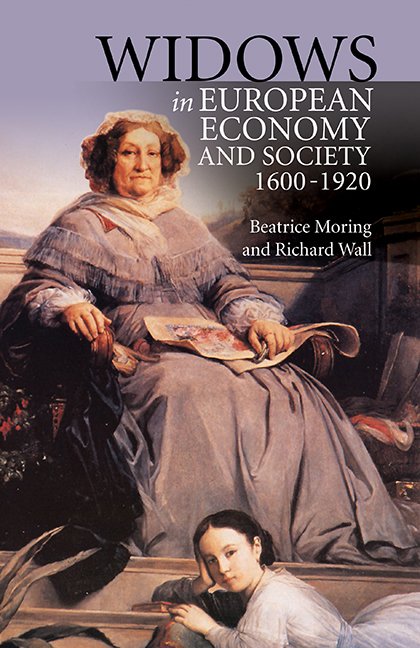Book contents
- Frontmatter
- Contents
- List of Plates
- List of Tables
- Acknowledgements
- Introduction
- 1 Widows and Poverty
- 2 Widows, Legislation and Property
- 3 Assessing the Assets of the Widow
- 4 Life Interest, Usufruct or Pension, The Mainstay of the Widow?
- 5 Urban Widows, Economy and Family
- 6 The Demography of Widowhood
- 7 Household Structure, Age, Social Status and Geography
- Conclusion
- Appendices
6 - The Demography of Widowhood
Published online by Cambridge University Press: 30 August 2017
- Frontmatter
- Contents
- List of Plates
- List of Tables
- Acknowledgements
- Introduction
- 1 Widows and Poverty
- 2 Widows, Legislation and Property
- 3 Assessing the Assets of the Widow
- 4 Life Interest, Usufruct or Pension, The Mainstay of the Widow?
- 5 Urban Widows, Economy and Family
- 6 The Demography of Widowhood
- 7 Household Structure, Age, Social Status and Geography
- Conclusion
- Appendices
Summary
IN her 1984 article ‘Women without men’, Olwen Hufton queried why women have persistently been viewed primarily as wives and household members, as additions to men and not individuals, in family history research. In 2001, the same question was repeated by Lynn Abrams.1 The tendency to discuss women as having been in need of the protection of a man and, therefore, assumed to have desired marriage and remarriage in the past, while not always explicitly stated, seems often to be implied in studies of demographic history.
There are two popular and widespread images of widowhood in the past: one is the young widow with many fatherless children, in need of assistance; the other is the old, lonely and poor widow, also in need of help. It is likely that these images originate in poor-relief records, but it is unclear how representative they are of the historical past. We have seen that the law and property systems protected a not insignificant part of widows from such a fate. We will discuss the demographic parameters underlying the structure of widowhood and the effects such parameters could have on access to family and the opportunities for collaboration from the point of presence of children.
How many widows were there, were they old or young, did they rush into remarriage or enjoy their freedom, were they burdened by large numbers of children or had the children been scooped up by infant mortality?
The Proportion of Widows – There's One In Every Street
It is difficult to find information about the number of widows, on a national level, in the pre-industrial period. Local studies, however, have revealed that thirteen percent of household heads and fifteen percent of the female population in seventeenth-century Britain were widows. In urban areas, like Southampton, as many as sixteen percent of all adult women were widowed. Seventeenth- and eighteenth-century German and French towns display a variation between eleven and fourteen percent. The situation was not very different in the countryside. Rural eighteenth-century French communities included twelve to fifteen percent widowed female household heads, and, for example in Austria, ten percent of the non-servant adult females were widowed.
- Type
- Chapter
- Information
- Widows in European Economy and Society, 1600-1920 , pp. 183 - 210Publisher: Boydell & BrewerPrint publication year: 2017



